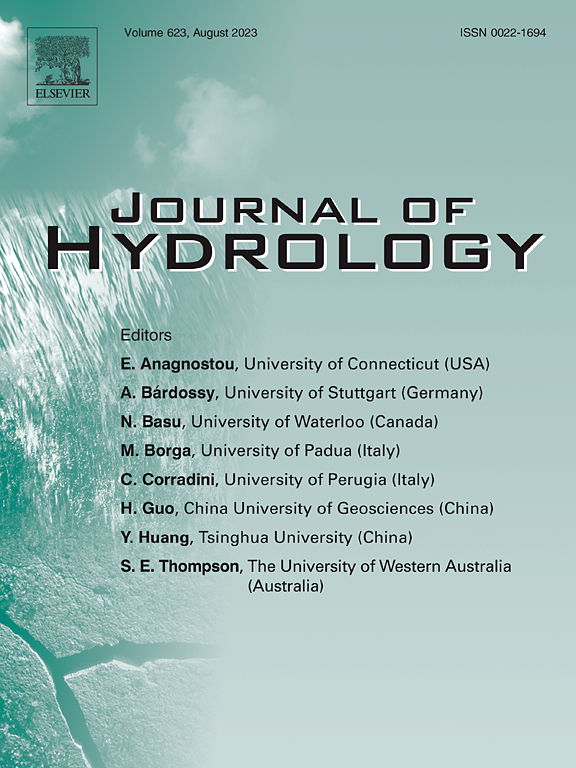Seasonal diversity of global flood changes and their drivers
IF 6.3
1区 地球科学
Q1 ENGINEERING, CIVIL
引用次数: 0
Abstract
Amplified extreme precipitations have been widely observed under global warming, while changes in seasonal floods over the globe and potential drivers remain insufficiently unknown. Here, we evaluated trends in seasonal floods (defined by seasonal maximum daily streamflow depth) based on in-situ observations of daily streamflow at 9678 stations over the globe and performed the quantitative attribution framework for seasonal flood changes based on all-subsets regression. Global assessments showed that the flood tended to decrease in spring, with significantly decreased (increased) floods at 14.4 % (9.0 %) of the total stations. These spring changes were associated with decreasing snowmelt at more than 75 % of stations containing snowmelt under global warming. In summer, the percentages of stations with significant decreases (13.5 %) and increases (12.0 %) in floods were similar, with regions showing decreased (increased) floods mainly due to decreased soil moisture (increased extreme precipitation and soil moisture). Floods tended to significantly increase in both autumn and winter at both 14.4 % of the total stations, which was related to increased extreme rainfall at 84.9 % of stations in autumn and 68.5 % of stations in winter. Increased rainfall is caused by more solid precipitation changed to liquid precipitation due to warming temperature. This study highlights the seasonal diversity of flooding change, as well as their responses to warming climate at global scale.
全球洪水变化的季节多样性及其驱动因素
在全球变暖的情况下,已广泛观测到极端降水的加剧,而全球季节性洪水的变化及其潜在驱动因素仍然不够清楚。本文基于全球9678个站点的日流量现场观测数据,评估了季节性洪水(以季节最大日流量深度定义)的变化趋势,并基于全子集回归建立了季节性洪水变化的定量归因框架。全球评价结果显示,春季洪水呈减少趋势,占总站的14.4%(9.0%)的洪水明显减少(增加)。这些春季变化与全球变暖下75%以上的融雪站融雪量减少有关。在夏季,洪水显著减少(13.5%)和显著增加(12.0%)的站点所占百分比相似,主要是由于土壤水分减少(极端降水和土壤水分增加)导致洪水减少(增加)。洪水在秋季和冬季都有显著增加的趋势,占总站数的14.4%,这与秋季和冬季极端降水增加有关,分别占84.9%和68.5%。降雨增加是由于温度变暖导致更多的固体降水转变为液体降水。这项研究强调了洪水变化的季节性多样性,以及它们对全球范围内气候变暖的响应。
本文章由计算机程序翻译,如有差异,请以英文原文为准。
求助全文
约1分钟内获得全文
求助全文
来源期刊

Journal of Hydrology
地学-地球科学综合
CiteScore
11.00
自引率
12.50%
发文量
1309
审稿时长
7.5 months
期刊介绍:
The Journal of Hydrology publishes original research papers and comprehensive reviews in all the subfields of the hydrological sciences including water based management and policy issues that impact on economics and society. These comprise, but are not limited to the physical, chemical, biogeochemical, stochastic and systems aspects of surface and groundwater hydrology, hydrometeorology and hydrogeology. Relevant topics incorporating the insights and methodologies of disciplines such as climatology, water resource systems, hydraulics, agrohydrology, geomorphology, soil science, instrumentation and remote sensing, civil and environmental engineering are included. Social science perspectives on hydrological problems such as resource and ecological economics, environmental sociology, psychology and behavioural science, management and policy analysis are also invited. Multi-and interdisciplinary analyses of hydrological problems are within scope. The science published in the Journal of Hydrology is relevant to catchment scales rather than exclusively to a local scale or site.
 求助内容:
求助内容: 应助结果提醒方式:
应助结果提醒方式:


